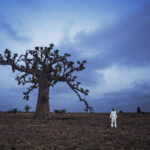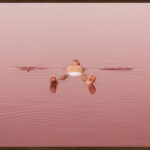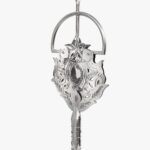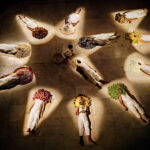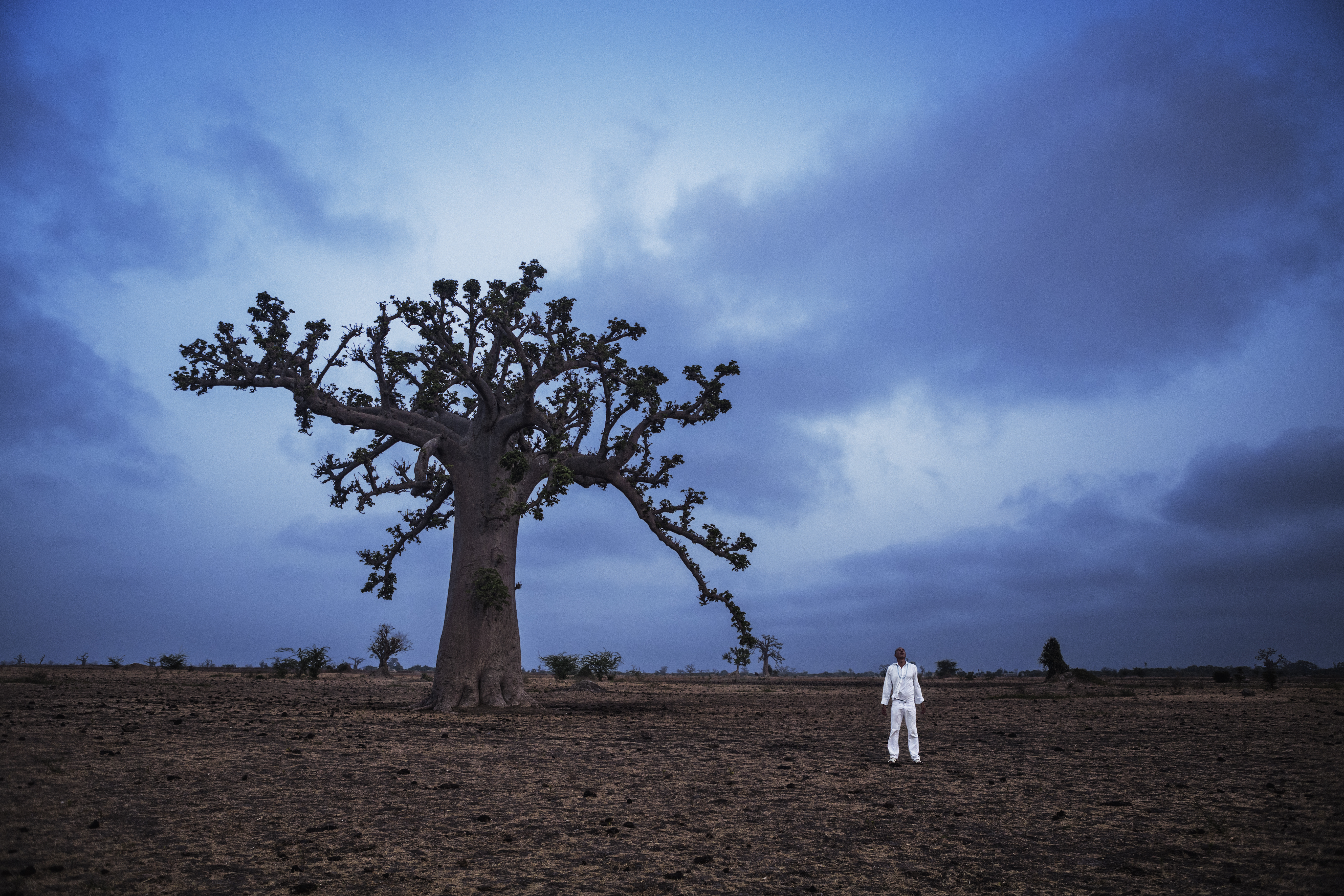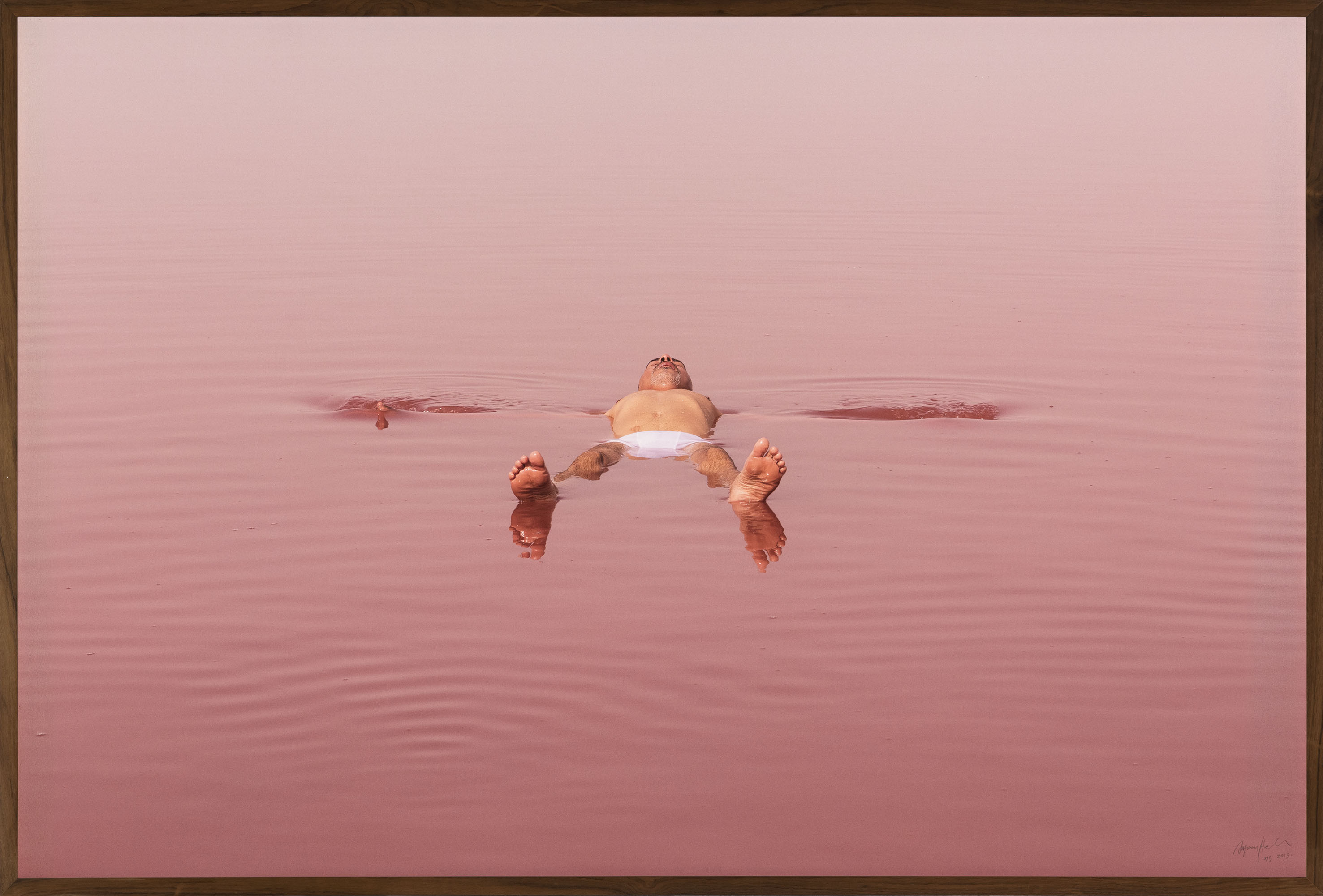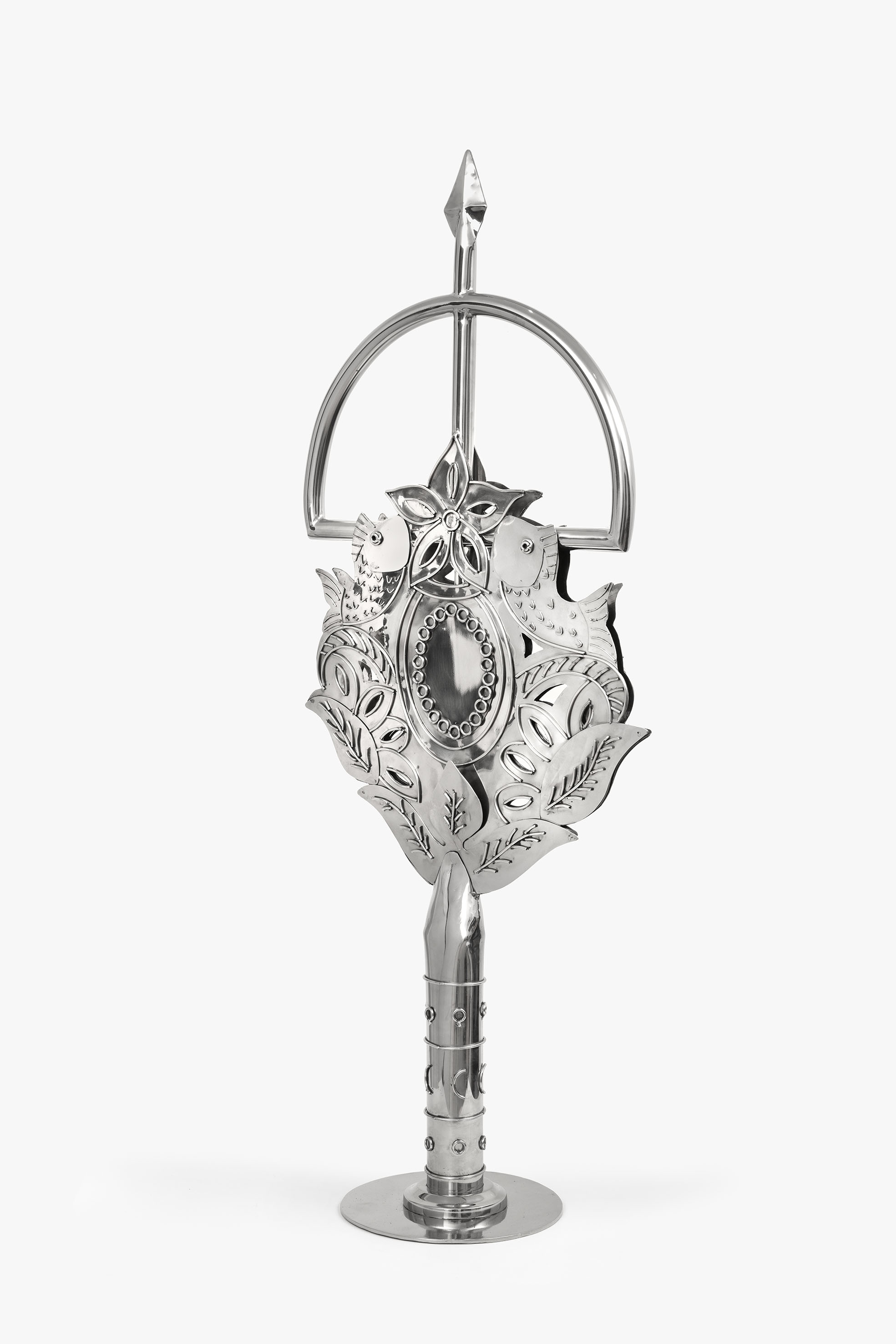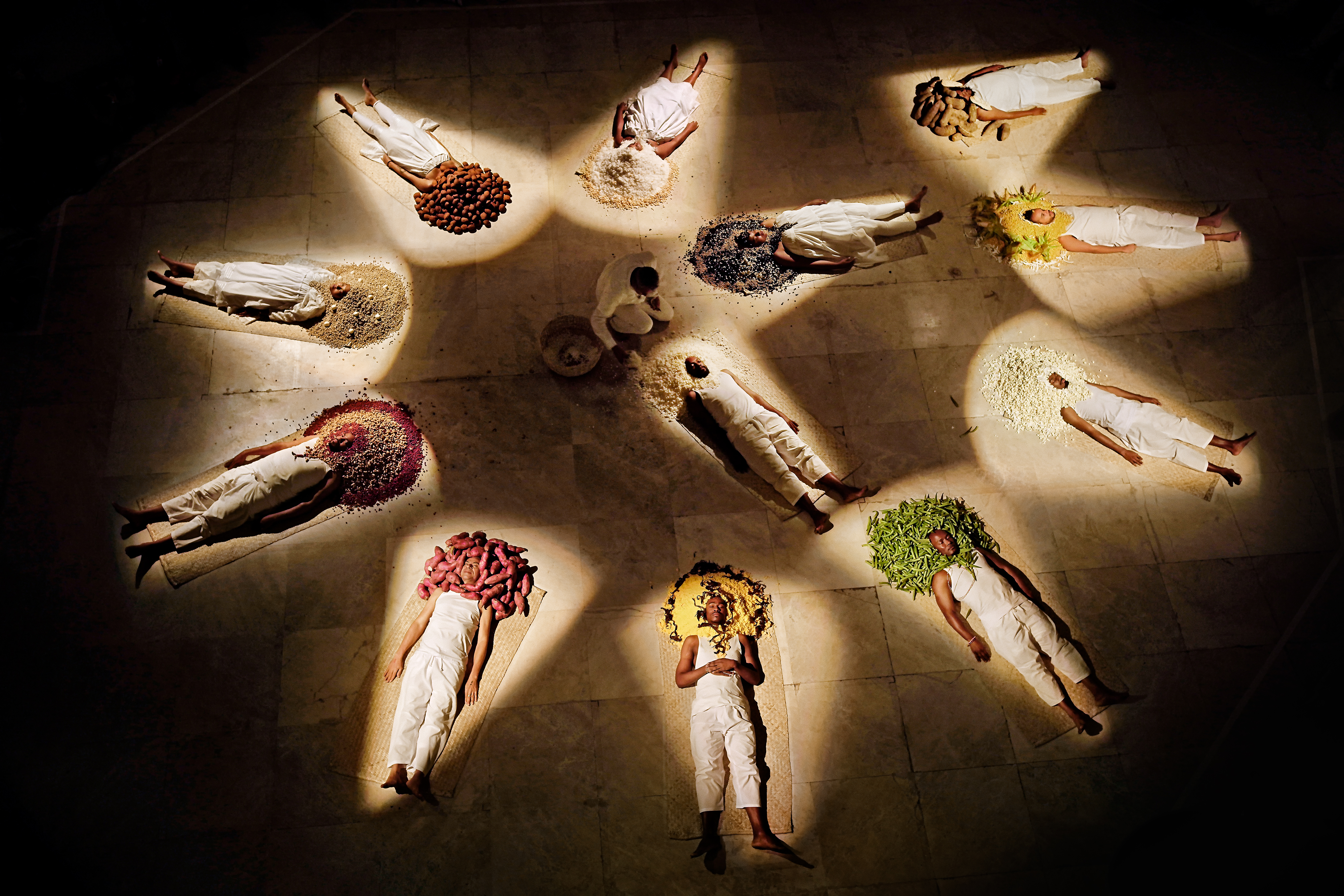With works in painting, photography, audiovisual, installations and performances, lately developed through organic materials – palm oil, jerked beef, sugar -, his work proposes a reading of the Bahia’s culture from the art, the history and sociology, mainly using in his performances and installations the incorporation of sounds, smells, in an artistic activity, where the actions use the organic material to create artistic objects out of the context of his daily life and from them, a reflection about the ephemeral of life. This concept takes him to a reading of the cultural history of Bahia, proposing a reflection on the African-Bahia cultural issues, the slavery, transport across the Atlantic, space and time, when presenting several forms of abuse to the body, the black body during the period of slavery of the body of people hunted in times of military dictatorship in Brazil and current slaveries. A work defiant in its reading of the man and the world of today.
Born in the city of Macaúbas, Bahia, in 1968, visual artist, researcher, curator, professor, he has a Master’s Degree in Fine Arts from Universidade Federal da Bahia, and his works are exhibited in national and international individual and collective exhibits – III Bienal do Mercosul/Mercosul/2001; II Trienal de Luanda/2010; Design 21/2001, in New York; MIP2 Manifestação Internacional da Performance, Belo Horizonte, Minas Gerais/2009 –, and it is represented in collections, such as Museum der Welkulturen, Frankfurt/Germany; Museu de Arte Moderna da Bahia; VídeoBrasil, private collections, earning awards since 1986 in the I Salão Metanor/Copenor de Artes Visuais da Bahia.
You were born in Macaúbas, city of the state of Bahia. What is there of this city in your work? What references marked you? What is there of your personal history in your creation as a visual artist?
I was born in 1968, in the far land of Macaúbas, city of the Bahia’s sertão, at 682 km from the capital, in the southern part of Chapada Diamantina. I’m the fourth son of an interracial union: my father, black man from Coração de Maria, BA, sargent of the Military Police, and my mother, white woman from Caturama, BA, History teacher. My maternal grandfather didn’t approve my parents union, undoubtedly due to racial prejudice. In 1970, my family was transferred to Vitória da Conquista, a big city southwest of Bahia, homeland of Glauber Rocha. I came back to Macaúbas several times during my youth, in school vacations and, especially, to the June celebrations, to the family gathering of my maternal relatives. I didn’t have much interaction with my father’s family. The city was very special to me, it had a culture markedly sertaneja and different habits from the southwest. The taste and smell of pequi fruit in the rice, the flavor of buriti sweets, the chopped palm with dry meat and the occasional walks through the caatinga, to harvest umbu fruit. I lived since my childhood the cultural contrast between these two cities. Macaúbas marked me deeply with its landscape of sertão and its strict, almost medieval, moral values.
The first contact I could have with your work was in 1986, at the Salão Metanor/Copenor. And a painting was exhibited. Looking at your exhibitions from then onwards, was the painting forgotten, or at least put aside, in front of the performances and videos in your work for exhibits? Is there no more place for painting in contemporary visual arts?
I always considered myself a painter, even when using other creative strategies. My thinking is pictoric, I thinl all the time in colors, textures, surfaces, matters and their communication senses. Artists such as Giorgone, with his supernatural lighting, Ticiano, especially in his old age, with his dramatic compositions, and the radical contrasts of light-dark were my great references in the 80’s. However, in the beginning, I had the need to state that the painting was dead. Because the contexts were others in Bahia, there was an almost complete supremacy of the fine arts. I felt distressed with the traditional supports and current concepts of art. During that period, I studied and was fascinated by the process that led to the work of Helio Oiticica, from the plane to the space, being inevitable, afterwards, the immersion in the installation and performatic audiovisual practices. Currently, it is a fact that, and there is no need of activism to assure it, there is an overflow, an over-stretching of boundaries between artistic languages. The movie and visual arts meet in an effective way, the engraving with the performance, the dance with technological interactivity, the music with installation. Painting will always have space in present time, but it should be conceptually thought in a dynamic, hybrid manner, as are sculpture, engraving and architecture.
With this opened range for audiovisual, photographs, etc. Is it the contemporaneity that requires this polyvalence, “everything at the same time now”, or is it an internal artistic need, what makes the artist to encompass all these fields in the visual arts?
I rather use the term “current art” than “contemporary art”. Therefore, the creative present time teach us and guide us more and more to the end of the unambiguous boundaries. About that, I report myself to the use of a more comprehensive concept, an expanded comprehension, in order to handle the complexity of the polyvalence phenomenon. I keep affirming that there is no support in art; what is there are strategies that crystallize creative energies of culture. I understand in this context the concept of creative strategies, such as the art of applying and exploring favorable conditions, with the means and purposes of achieving specific objectives. We have today several methods and procedures of language in order to communicate “visual poetry”, being the artist liable for choosing which one is more relevant – in my case, the most efficient one. Every process is particular and, as we are all “poets”, inventors, or creators of new possibilities of being, we build our paths and routes while subjectiving ourselves.
Visual arts, today, still maintain a division of fields of acting – painting, sculpture, photography, etc. – or all of it has to interact in order to fully perform the creation that is required from a current artist?
I don’t get motivated by art manifestos, because almost all of them, historically, are quite essentialist and authoritarian. I suggest we observe the results of the document prepared by Funarte and the civil society in the meetings in the Câmaras Setoriais de Artes Visuais in 2006 and verify a great update of the conceptual field of the area: “The ‘fine arts’ – as they have been known until a short while ago – gained a new dimension. They will be known as ‘visual arts’. It integrates the circle of the ‘visual arts’, those forms of artistic expression that, having as a center the visuality, generate, for whatever understandable instruments and/or techniques, images, objects and actions (material or virtual), necessarily, through the sense of vision, and may be amplified to the other senses. Starting from this center, the circle expands, aggregating their miscellaneous manifestations, until the circumference of the visual arts reaches (and penetrates) other art circles centered by other values, generating zones of intersection that hold mixed manifestations, that don’t stop being ‘visual’, but obey, with equal or greater emphasis, other logics. This circle and its intersections compose the field of visual arts”. This document informs us about the concept updating, and that there is no division, but rather an amplification of the field to encompass the present time.
So, let’s enter your works. Your creation has been featured by the use of organic materials. Ephemeral matters. What is the meaning of the transience as a boosting element for your works?
I’m a man from sertão who loves the hinterland of Baía de Todos os Santos, namesake of the Greek philosopher Heraclitus, who taught us: you cannot enter twice in the same river. I think I’ve inherited the karma. But life and its transience, its fluidity, and the transformation of the things in the world, for me, continue to be as challenging as fertile to the fomentation of reflection and intellectual creation. Organic material is lively and dynamic, as well as the use I make when I re-signify it to think the our cultural traditions.
Still on what boosts to creation, there is the reading of a social, economical, political, cultural history through the use of materials such as palm oil, jerked beef, etc. Is your goal when creating your artworks and using these materials to say that an artwork necessarily has to have an intellectual reflection, make people think?
I believe in the educational and expressive conceptions of art and its relation as a form of knowledge. Consequently, the greater reason of my search is to build a visual poetry. And to investigate about the artistical possibilities of regional raw materials. That’s why I elect the organic materials – sugar, jerked beef and palm oil – eliciting their fine and visual senses, as an emblem of a possible synthesis of cultural traditions. For me, the artistic work should affect, that is, reach to the affection – which is a mix of perception and concept.
The previous question may be yet unfolded into another one. Should the artwork reflect the social context in which it is made, the reality of the society where it is inserted? And it may still go on: what is the role of a contemporary artist before his/her reality?
I was a militant of the Communist Party at 13 years old. I sold Tribuna Operária, got involved with the secondary student movement – when I read Capital: Critique of Political Economy, by Marx. Then, I was profoundly touched by the lessons of art and life of the artist Joseph Beuys. Therefore, while an artist and scholar, my education is built on the belief that historically, art is determined socially.
I believe today that the classical conceptions of engaged art and of art for art’s sake should be comprehended in their historical contexts. Activism has changed. Today, we fight for free softwares and clean energy to produce a more sustainable world. Art and the artist relate to one another in an effective manner as a language, i.e., as a communication strategy. So, we should seek the balance between activism or the creative intervention in the world and the effective methods of artistic production. The artist, today, is also a type of architect of information – who poetically orchestrates their words and their actions, thus undertaking the function of dialoging, triggering their social context, in a way to recognize practices of alterities that enable collaborative exchanges.
Your last exhibitions require an interaction, because they have been performed in a fashion show, a square, or even in galleries. Does it require the acting, that is, reflexive spectator? Is this spectator also an inherent part of the work? Or does the work only require reflection? Better yet: what is the role of the audience before an artwork today?
Art always existed to say something. I always preferred to say and been attentive to listening. That’s why, a horizontal relation with the audience is essential for my creative practice. The reception of art should be phenomenologically the intermediation; in the present time, the dynamic exchange between artistic proposals, creative people and social contexts.
Another data in your creation, in the meeting between history and the present, is to elicit a whole imaginary of the Brazilian, specifically the Bahian, proposed in the symbolic materials, such as the use of history reflected in these materials. What do you identify as a fundamental element to deflagrate your creation? What is the starting point for your artistic creation?
I always believed that art also moves in other times besides the chronological one. As in the time of mental structures, which is slower, independent from the historical time, and the mythical structures, which regards the sacred and metaphysical.
The reading I make between history and the present has the intension of comprehending the complexity of cultural phenomena related to the symbolic and imagery dimension of what makes us Brazilian, taking into account its inventive and fictional characteristic – which moves me to investigate through interterritories of knowledge. Without a doubt, I’ve taken my time on the African-Brazilian themes and their miscellaneous scenes, because I think they were not exhausted and they need to be read at another perspective.
Certainly, the research of Afro-Bahian themes is not recent in the history of Bahia’s art. However, what we propose with our poetry is a type of methodology and approach always with a criticism horizon that indicates more contemporary readings that involve the issue of local and global territory. Bahian cultures fascinate me and, as I still consider myself a painter, the starting point for my creation is how I relate myself with my landscape.
After your exhibition with jerked beef, you’ve donated the meat to institutions. You’ve received their gratitude in writing. These letters became works. Is this ‘recycling’, this continuous remaking of yourself is also an objective of your work?
Through esthetical lessons from Joseph Beuys, I learned how to understand art through an anthropological perspective, thinking the artistic creation while “social sculpture”, the possibility of molding in plasticity the social relations. Consequently, my work does not finish entirely in the art system. The documents and the residual production that register actions and re-signify your memory are essential for the construction of my poetry.
You had the opportunity of exhibiting in Angola. What did this trip do with the artist Ayrson Heráclito as a reflection of Brazil and what could be changed in your interaction with the Brazilian reality?
Unfortunately, I wasn’t in Angola – although my works have been exhibited in the Trienal de Luanda. My axé (energy) went there. I was present, but in another form.
I’m very curious to meet the Africas, because I’m in love with part of its history. However, I wait patiently by the possibility of facing what we’ve reinvented of Africa in Bahia, in Brazil, in America, with an in loco living. I’m prepared to teach and learn, demystify and recognize analogies in this experience.
What are the ways of the artist Ayrson Heráclito now? What are you doing? Any project?
Many paths are opened. Ogum iê! I’m a son of Odé, I’m always hunting, providing my home with abundance and food. I’m transfering myself to an academic qualification – in which I intend to receive my academic deká (title) of doctor. For four years, I’ll be between São Paulo, the Brazilian Northeast region, Europe and my so mystic Africa. Still in this year, I’ll exhibit a new video-installation in the Festival de Arte Eletrônica VideoBrasil, in São Paulo, and, subsequently, I’ll participate in three important exhibits in Europe, among the Netherlands and Belgium. I produce a lot, actually. And for some time, I’ve been working in the creation of several products of video-installations and performances that involve the technology of DSLR. I’m finishing three new projects that talk about the Festival da Liberdade do Bembé in the Bahia’s Recôncavo.
(Interview/September, 2011)


